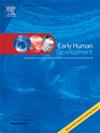接受肠外营养的早产儿的代谢性骨病:发病率、临床、实验室和营养概况
IF 2.2
3区 医学
Q2 OBSTETRICS & GYNECOLOGY
引用次数: 0
摘要
新生儿代谢性骨病(MBD)的特点是在出生后第3周至第12周出现组织减少和产后骨矿化不足的临床、实验室和/或放射学反应,最严重的形式可导致生长缺陷和骨折。本研究的目的是评估在新生儿重症监护病房(NICU)接受肠外营养治疗15天的早产儿MBD的发生率,并评估其临床和实验室特征。方法采用单中心回顾性队列研究。从2015年到2020年,对符合代谢性骨病标准(碱性磷酸酶800 U/L,磷3.5 mg/dL和/或兼容的影像学改变)的33周孕龄或1500 g出生体重接受肠外营养15天的患者进行评估。排除标准:骨骼发育不良、骨科手术、III级和IV级脑室内出血、脑室周围白质软化、慢性肾衰竭或严重肝病。在出生和/或出院/死亡的前90天收集临床、实验室和放射学数据。结果5年间MBD的发病率为17.7%。出生时胎龄26±1.41周;出生体重为745(592-858)克;碱性磷酸酶最高为1091±243.87 U/L,磷最低为2.45±0.48 md/dL。14例代谢性骨病中,实验室诊断12例,影像学诊断6例,两者均有4例;2例患者骨折;42%的患者接受了肠内钙磷补充,50%的患者接受了静脉补钙。结论代谢性骨病发病率与国际文献一致。在大多数情况下,代谢性骨病的诊断是基于实验室检测的监测。然而,代谢性骨病的治疗需要在危险人群中采取更积极的预防措施。本文章由计算机程序翻译,如有差异,请以英文原文为准。
Metabolic bone disease in premature infants receiving parenteral nutrition: Incidence, clinical, laboratory and nutritional profile
Background
Metabolic bone disease (MBD) of newborns (NB) is characterized by tissue reduction and inadequate postnatal bone mineralization with clinical, laboratory, and/or radiologic repercussions between the third and twelfth weeks of postnatal life, which, in its most severe forms, can lead to a growth deficit and fractures. The aim of our study is to evaluate the incidence of MBD in premature patients receiving parenteral nutrition for >15 days in the neonatal intensive care unit (NICU) and assess their clinical and laboratory characteristics.
Methods
Single-center retrospective cohort study. From 2015 to 2020, patients <33 weeks of gestational age or <1500 g birth weight receiving parenteral nutrition for >15 days who met the metabolic bone disease criteria (alkaline phosphatase >800 U/L and phosphorus <3.5 mg/dL and/or compatible radiological alterations) were evaluated. Exclusion criteria: skeletal dysplasia, orthopedic surgeries, intraventricular hemorrhage grades III and IV, periventricular leukomalacia and chronic renal failure or severe liver disease. Clinical, laboratory and radiological data were collected during the first 90 days of life and/or discharge/death.
Results
The MBD incidence was 17.7 % over a five-year period. The gestational age at birth was 26 ± 1.41 weeks; birth weight was 745 (592–858) grams; maximum alkaline phosphatase level was 1091 ± 243.87 U/L and phosphorus nadir was 2.45 ± 0.48 md/dL. Among the 14 patients with metabolic bone disease, twelve had laboratory diagnosis, six had radiological and four had both; two patients had fractures; 42 % of patients received enteral calcium and phosphorus supplementation, and 50 % received intravenous calcium replacement.
Conclusions
Metabolic bone disease incidence was in accordance with international literature. The metabolic bone disease diagnosis was, in most cases, based on surveillance of laboratory tests. However, treatment for metabolic bone disease requires more active and preventive measures in risk groups.
求助全文
通过发布文献求助,成功后即可免费获取论文全文。
去求助
来源期刊

Early human development
医学-妇产科学
CiteScore
4.40
自引率
4.00%
发文量
100
审稿时长
46 days
期刊介绍:
Established as an authoritative, highly cited voice on early human development, Early Human Development provides a unique opportunity for researchers and clinicians to bridge the communication gap between disciplines. Creating a forum for the productive exchange of ideas concerning early human growth and development, the journal publishes original research and clinical papers with particular emphasis on the continuum between fetal life and the perinatal period; aspects of postnatal growth influenced by early events; and the safeguarding of the quality of human survival.
The first comprehensive and interdisciplinary journal in this area of growing importance, Early Human Development offers pertinent contributions to the following subject areas:
Fetology; perinatology; pediatrics; growth and development; obstetrics; reproduction and fertility; epidemiology; behavioural sciences; nutrition and metabolism; teratology; neurology; brain biology; developmental psychology and screening.
 求助内容:
求助内容: 应助结果提醒方式:
应助结果提醒方式:


